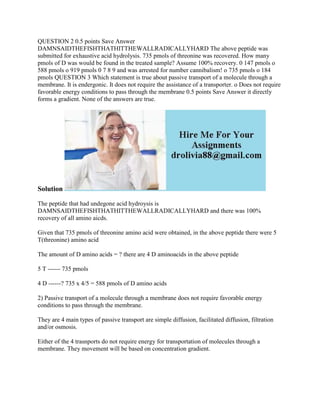QUESTION 2 0-5 points Save Answer DAMNSAIDTHEFISHTHATHITTHEWALLRADICAL.docx
QUESTION 2 0.5 points Save Answer DAMNSAIDTHEFISHTHATHITTHEWALLRADICALLYHARD The above peptide was submitted for exhaustive acid hydrolysis. 735 pmols of threonine was recovered. How many pmols of D was would be found in the treated sample? Assume 100% recovery. 0 147 pmols o 588 pmols o 919 pmols 0 7 8 9 and was arrested for number cannibalism! o 735 pmols o 184 pmols QUESTION 3 Which statement is true about passive transport of a molecule through a membrane. It is endergonic. It does not require the assistance of a transporter. o Does not require favorable energy conditions to pass through the membrane 0.5 points Save Answer it directly forms a gradient. None of the answers are true. Solution The peptide that had undegone acid hydroysis is DAMNSAIDTHEFISHTHATHITTHEWALLRADICALLYHARD and there was 100% recovery of all amino aicds. Given that 735 pmols of threonine amino acid were obtained, in the above peptide there were 5 T(threonine) amino acid The amount of D amino acids = ? there are 4 D aminoacids in the above peptide 5 T ------ 735 pmols 4 D ------? 735 x 4/5 = 588 pmols of D amino acids 2) Passive transport of a molecule through a membrane does not require favorable energy conditions to pass through the membrane. They are 4 main types of passive transport are simple diffusion, facilitated diffusion, filtration and/or osmosis. Either of the 4 trasnports do not require energy for transportation of molecules through a membrane. They movement will be based on concentration gradient. .

Recommandé
Recommandé
Contenu connexe
Plus de kevin792
Plus de kevin792 (20)
Dernier
Dernier (20)
QUESTION 2 0-5 points Save Answer DAMNSAIDTHEFISHTHATHITTHEWALLRADICAL.docx
- 1. QUESTION 2 0.5 points Save Answer DAMNSAIDTHEFISHTHATHITTHEWALLRADICALLYHARD The above peptide was submitted for exhaustive acid hydrolysis. 735 pmols of threonine was recovered. How many pmols of D was would be found in the treated sample? Assume 100% recovery. 0 147 pmols o 588 pmols o 919 pmols 0 7 8 9 and was arrested for number cannibalism! o 735 pmols o 184 pmols QUESTION 3 Which statement is true about passive transport of a molecule through a membrane. It is endergonic. It does not require the assistance of a transporter. o Does not require favorable energy conditions to pass through the membrane 0.5 points Save Answer it directly forms a gradient. None of the answers are true. Solution The peptide that had undegone acid hydroysis is DAMNSAIDTHEFISHTHATHITTHEWALLRADICALLYHARD and there was 100% recovery of all amino aicds. Given that 735 pmols of threonine amino acid were obtained, in the above peptide there were 5 T(threonine) amino acid The amount of D amino acids = ? there are 4 D aminoacids in the above peptide 5 T ------ 735 pmols 4 D ------? 735 x 4/5 = 588 pmols of D amino acids 2) Passive transport of a molecule through a membrane does not require favorable energy conditions to pass through the membrane. They are 4 main types of passive transport are simple diffusion, facilitated diffusion, filtration and/or osmosis. Either of the 4 trasnports do not require energy for transportation of molecules through a membrane. They movement will be based on concentration gradient.